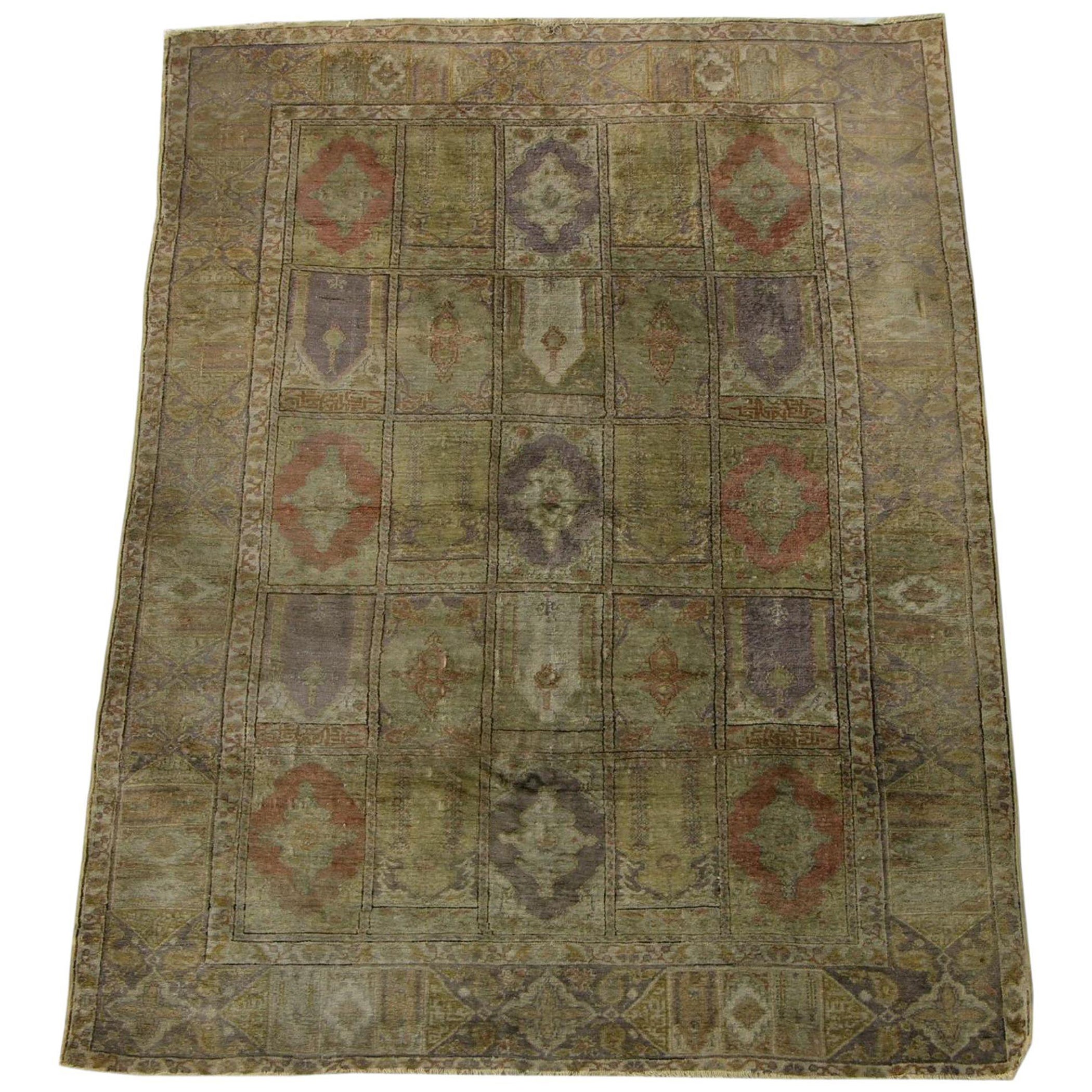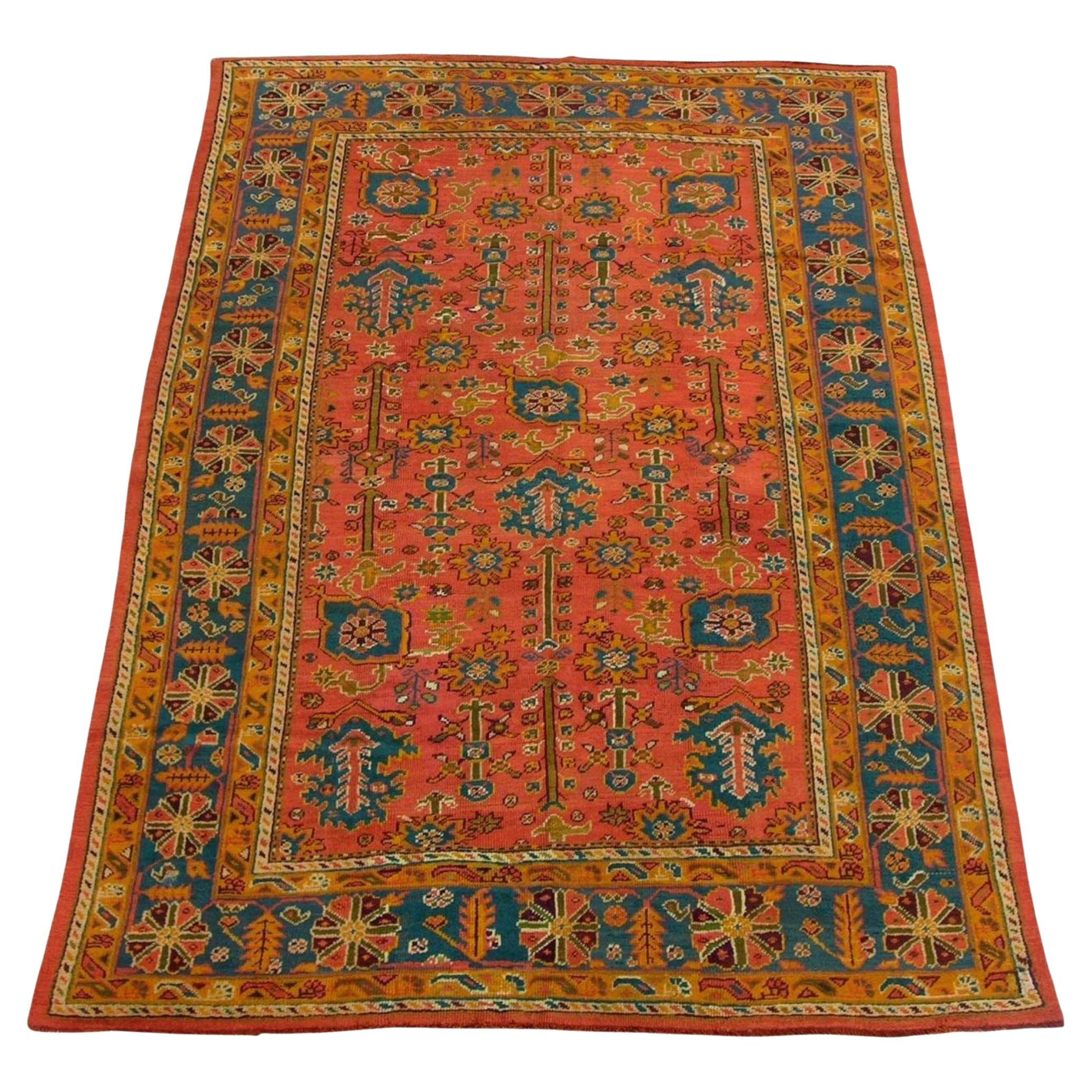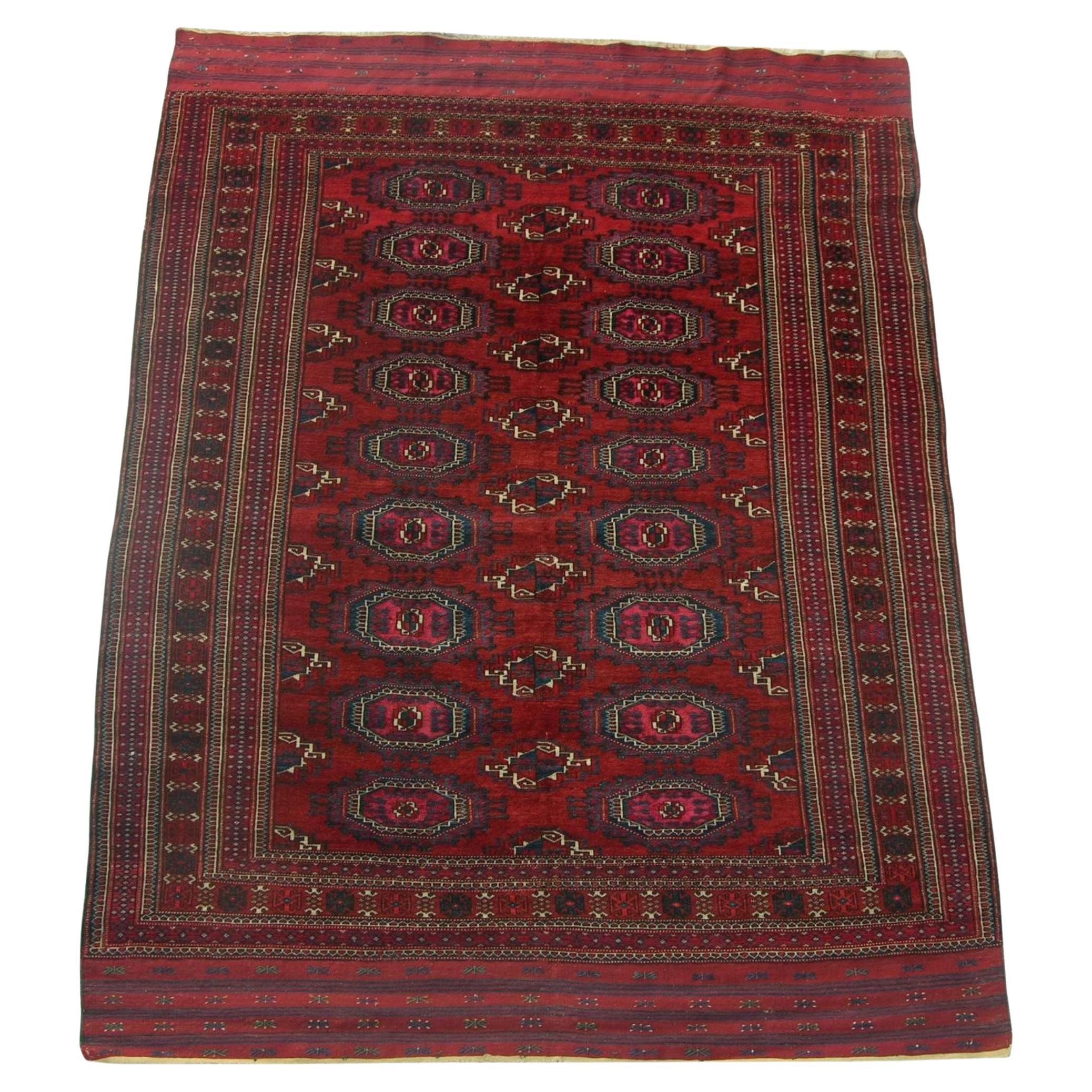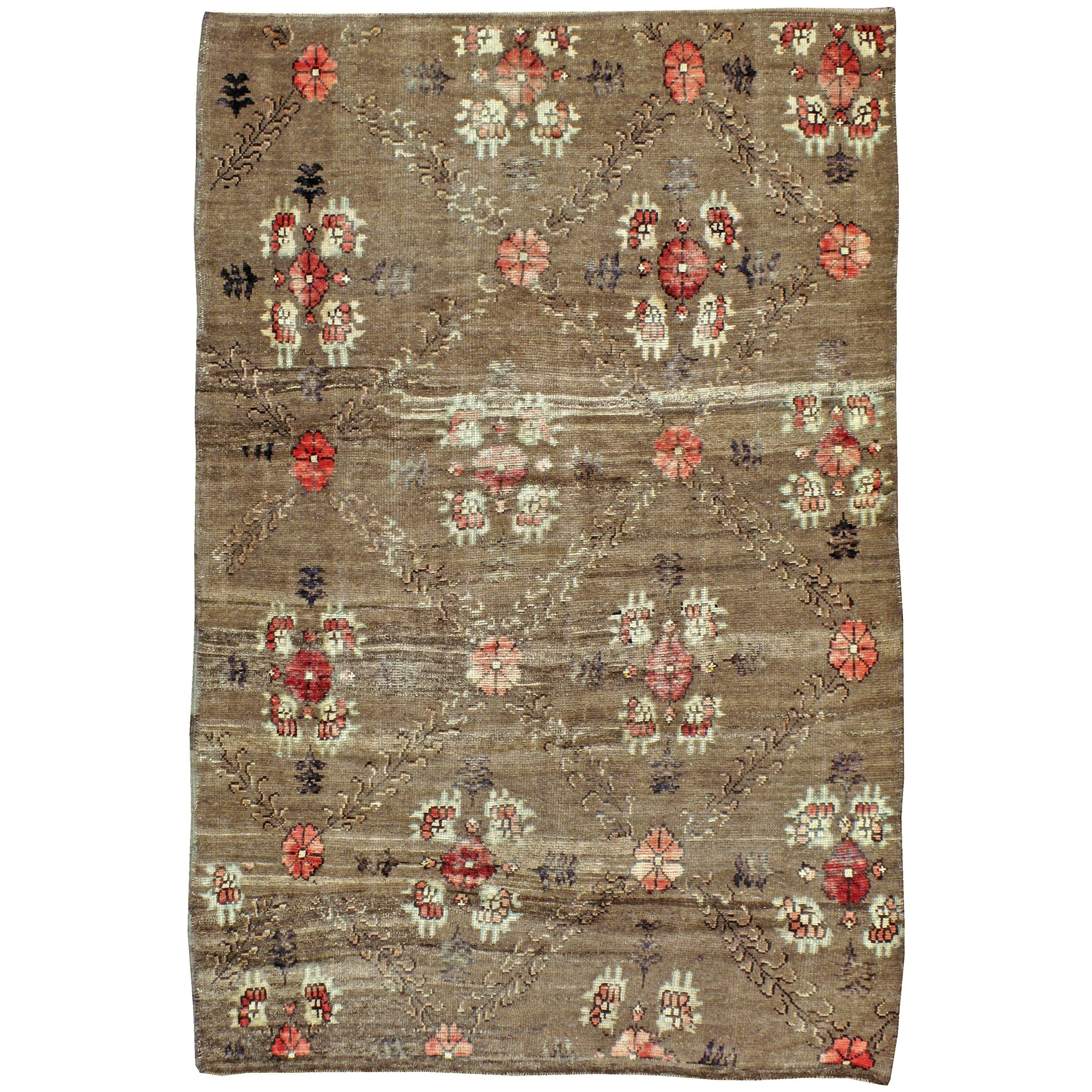Items Similar to Antique Turkish Silk Rug
Want more images or videos?
Request additional images or videos from the seller
1 of 5
Antique Turkish Silk Rug
About the Item
Turkish rugs (also referred to as Anatolian rugs) are, arguably, the rugs that started it all. These carpets were among the first wave of Oriental antique carpets to be exported into Europe. The vintage Turkish rugs were prized commodities and artistically influential pieces. The designs of Turkish rugs such as the iconic guls, prayer rugs and small repeating patterns found on these carpets, worked their way into the iconic paintings of the European masters, including Memling, Lotto, Bellini, Hans Holbein and many others.
These painters were inspired so much by Turkish rugs and the design motifs they feature that the artists have lent their names to some of these famous Turkish patterns. One of the most famous artists that incorporated rugs from Turkey in his painting was the great and iconic 16th century painter Hans Holbein.
The styles of Turkish rugs varies widely. Bergama rugs, for example, produced tribal-influenced Turkoman pieces, Hereke rugs feature elegant curve-linear patterns worthy of Ottoman palaces and the most well known of all rug weaving centers in Turkey – Oushak produces decorative room-sized carpets that are revered, above all else, for their soft pastel-coloration.
The Romanian master weaver – Theodor Tuduc, also produced exceptional carpets. His rugs were based on existing styles and designs from the Caucasus, Turkey as well as Persia. Antique Turkish rugs are elegant and beautifully varied in look, texture, quality and design.
Turkish Rugs are a major component of the carpet weaving traditions in the Middle East. It was largely the Turkish people and related groups from Central Asia who introduced the knotted pile carpet to the Islamic world. The largest and oldest collection of early Oriental rugs comes from Turkey. The so-called geometric or Seljuk carpets from the thirteenth century have been well preserved in the mosques of Konya and other towns in Central Anatolia. While most antique Persian rugs are fine and intricate, the antique Turkish rugs are extremely desirable by interior decorators. Since many of the antique rugs from Turkey boast larger scale design patterns that are usually also set against softer colors, they do have a very decorative appeal. The early Turkish rugs are also some of the most collectible rugs in today’s market due to their more primitive designs and the fact that not many were produced.
- Dimensions:Width: 81 in (205.74 cm)Length: 108 in (274.32 cm)
- Style:Other (In the Style Of)
- Materials and Techniques:
- Place of Origin:
- Period:1900-1909
- Date of Manufacture:1900
- Condition:good condition.
- Seller Location:Los Angeles, US
- Reference Number:
About the Seller
5.0
Gold Seller
These expertly vetted sellers are highly rated and consistently exceed customer expectations.
Established in 1920
1stDibs seller since 2023
26 sales on 1stDibs
Typical response time: <1 hour
- ShippingRetrieving quote...Ships From: Los Angeles, US
- Return PolicyA return for this item may be initiated within 3 days of delivery.
More From This SellerView All
- 1900s Fine Antique Prayer Turkish Silk Rug - 5'5'' X 3'10''Located in Los Angeles, USSilk Rugs – Silk Carpets and area rugs are the most luxurious productions of their kind. The silk textile production began in China, although silk rugs are unattested there until the seventeenth century. Silk textile manufacture was well established in Persia by the Sassanian Period (third to seventh centuries). Consequently, it would have been possible for the Persians of this period or those of Early Islamic times to have adapted silk to rug production. But it is so far unclear whether China or the Islamic Orient initiated the manufacture of silk carpets. At any rate, the earliest extant of all the antique handmade silk rugs are in fact the handmade Persian silk rugs...Category
Antique Early 1900s Asian Other Russian and Scandinavian Rugs
MaterialsWool, Cotton
- 1920s Antique Fine Turkish Oushak RugLocated in Los Angeles, USAntique Turkish Oushak rugs have been woven in Western Turkey since the beginning of the Ottoman period. Historians attributed to them many of the great masterpieces of early Turkish...Category
Antique Early 1900s Asian Tribal Russian and Scandinavian Rugs
MaterialsWool
- Antique Turkmen Salor Part Silk Rug Geometric DesignLocated in Los Angeles, USSalor rug, floor covering handmade by the Salor Turkmen of Turkmenistan. Most consistent in design are the main carpets, with a quartered gul (motif) showing...Category
Antique Early 1900s Asian Other Russian and Scandinavian Rugs
MaterialsWool, Silk, Cotton
- Antique Abstract Turkish OushakLocated in Los Angeles, USntique Turkish Oushak rugs have been woven in Western Turkey since the beginning of the Ottoman period. Historians attributed to them many of the great masterpieces of early Turkish ...Category
Vintage 1920s Other Russian and Scandinavian Rugs
MaterialsWool
- Antique Sumak RugLocated in Los Angeles, USSoumak rugs (also spelled Sumak) – This construction technique produces a flat-weave rug that is thick, strong and exceptionally durable. Unlike kilims, Soumak rugs are not reversibl...Category
Antique Early 1900s Other Russian and Scandinavian Rugs
MaterialsWool, Cotton
- 1920s Antique Floral Design Part Silk Needlework RugLocated in Los Angeles, USNeedlepoint rugs were created using the traditional needlework weaving technique that is used to make everyday items from furniture to carpets and artwork. However, it has a fascinating history both as a hobby and as an industry. When many people think of carpets, they think of pile carpets or flat weave kilims, but needlepoint has also been used to create beautiful carpets. These carpets are durable and an important part of carpet history. Archaeologists and scholars consider the roots of needlepoint to have been around 1500 BC. They consider the first needlepoint to include the fine diagonal stitches that were used to sew tents together by the ancient Egyptians. The art eventually evolved into tapestry weaving. However, a tapestry weaving differs significantly from needlepoint in that it uses a loom and vertical warp. Tapestry weaving is closer to the weaving of kilims and pile rugs than canvas work. However, some still include tapestry weaving in the category of needlepoint because of the fine work that appeared during the late Renaissance. It can have a similar appearance to the untrained eye. Technically, tapestry weaving and needlepoint are not the same, and they do not use the same technique. The first actual needlepoint rugs and needle-points began to appear in the late Renaissance. Needlepoint is worked by creating stitches on a stiff canvas. The canvas is typically made from jute or linen and is quite durable. Pieces from the Renaissance were used to cover footstools, chairs, pillows, bed headboards, and other furnishings. They were also used as table coverings and wall coverings. You could also find them on many small items such as purses, shoes, and various adornments for clothing. During the Renaissance, the craft reached a high level of skill, and the designs became incredibly detailed and realistic. They mimicked many of the subjects and styles of famous paintings of the time. They created florals, still life designs, scenes, and geometric tiled pieces. Some of them mimicked the designs found in Persian Carpets. Needlepoint reached its peak popularity in the 19th century when it was considered a proper occupation for a lady. Needlepoint and embroidery held a similar place in societal status at the time. During this time, the work became finer, with some of the canvas reaching a high level of detail. The level of detail is determined by counting the number of mesh in an inch. During this time petit point by French needlewomen could have a mesh count as high as 45 mesh. This allowed women to create highly intricate designs with incredible levels of detail. It is possible to find many antique pieces of needlepoint besides rugs. Needlepoint rugs were popular in France and Spain, where the technique was adapted to create highly intricate designs that mimicked the designs in architecture and fashion. They were popular because they were durable, and it could be fashioned into a variety of items. The canvases themselves were durable, and the wool that they used was also strong, which means that many of the pieces were able to withstand daily use. We have many artifacts that have survived from this time period. Needlepoint rugs are important collectibles because they are different from the pile rugs and kilims that are typically found on the market. Needlepoint carpets are special because they take many hours to create, especially larger works. Needlepoint pieces of any type became popular throughout Europe during the 19th century. It is still a popular hobby today, but perhaps one of the most interesting stories is that of the Portuguese needlewomen of Arraiolos. The story of these women and their beautiful carpets begins in 1492. Needlepoint was a popular occupation in Spain, which had a large population of Moors and Jews. They were an integral part of Spanish culture. However, in 1492, Queen Isabella of Spain issued a proclamation that gave these ethnic groups the order to pack their bags and board ships headed...Category
Vintage 1920s Renaissance Revival Russian and Scandinavian Rugs
MaterialsWool, Silk
You May Also Like
- Beautiful Turkish Kilim Rug Antique of the 1940s, Tribal RugLocated in Bochum, NRWTurkish Kilim, of the 1940s. This colorful antique kilim has a bold presence provided by its graphic geometric motifs realized in shades of vivid green, sky blue, dark red, olive, ac...Category
Vintage 1940s Balkan Bessarabian Russian and Scandinavian Rugs
MaterialsWool
- Vintage Turkish RugLocated in New York, NYA vintage Turkish carpet from the second quarter of the 20th century.Category
Mid-20th Century Turkish Tribal Turkish Rugs
MaterialsWool
- Crimson Vintage Turkish RugLocated in New York, NYMidcentury Turkish deco rug in crimson red.Category
20th Century Turkish Mid-Century Modern Turkish Rugs
MaterialsWool
- Vintage Turkish Karabagh RugLocated in New York, NYA vintage Turkish Karabagh carpet from the mid-20th century.Category
Mid-20th Century Russian Kazak Russian and Scandinavian Rugs
MaterialsWool
- Antique Caucasian Area RugLocated in New York, NYCaucasian rugs are primarily produced as village productions rather than city pieces. Made from materials particular to individual tribal provinces, the rugs of the Caucasus normally...Category
Antique Early 1900s Russian Other Caucasian Rugs
MaterialsWool
- Turkish Marby Design Oushak RugLocated in Lohr, Bavaria, DEOne of a kind Turkish hand-knotted design rug. Very unusual in style and color. Hand-knotted with soft wool on wool warp and weft. Oushak Marby rug Turkey 9.6 x 8.0 ft / 294 x 243 cm...Category
Late 20th Century Turkish Turkish Rugs
MaterialsWool





